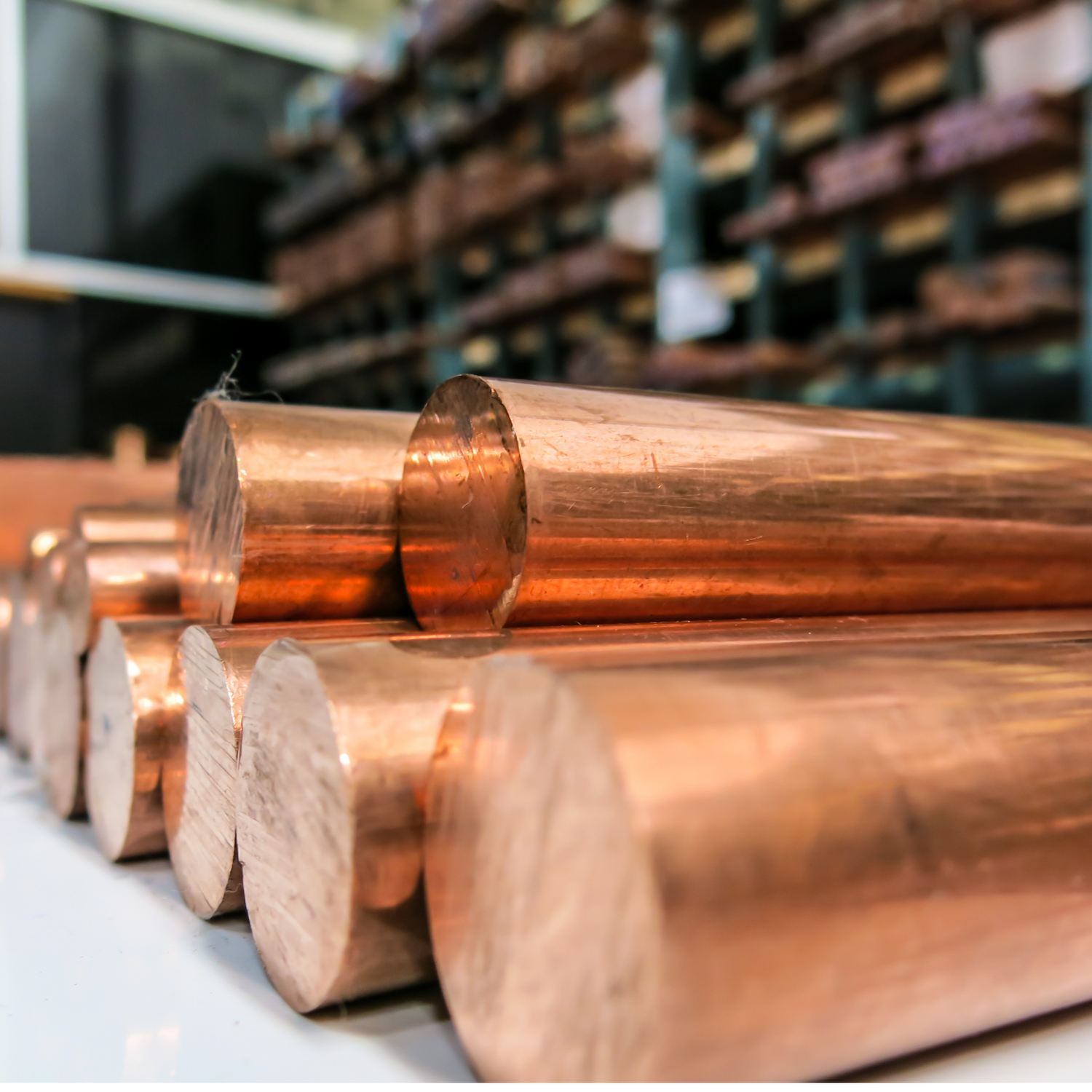
COPPER
The Essential Metal Driving Modern Infrastructure and Technology
Introduction to Copper
Copper (Cu), with atomic number 29, is a reddish-brown metal known for its excellent electrical and thermal conductivity, malleability, and resistance to corrosion. These properties have made copper indispensable in various applications, from electrical wiring to renewable energy systems. Recognized as a critical mineral, copper plays a pivotal role in the global transition towards sustainable energy and advanced technological infrastructure.

Geological Occurrence & Sources
Copper is primarily extracted from sulfide and oxide ores, with the most common copper-bearing minerals being chalcopyrite, bornite, and malachite. These ores are typically found in large, disseminated deposits known as porphyry copper deposits, as well as in sediment-hosted stratabound deposits.
Major Global Sources:
- Chile: The world’s leading copper producer, home to the massive Escondida mine.
- Peru: A significant contributor with large-scale operations like the Cerro Verde mine.
- China: Both a major producer and consumer of copper, with numerous domestic mines.
- United States: Notable for substantial production, particularly in states like Arizona and Utah.
- Australia: Hosts significant copper deposits, including the Olympic Dam mine.

Industrial Uses & Applications
Copper’s versatility and superior conductive properties make it essential across various industries:
Electrical & Electronics:
- Wiring and Cables: Extensively used in residential, commercial, and industrial electrical systems due to its excellent conductivity.
- Electronic Components: Integral in the manufacturing of circuit boards, connectors, and other electronic devices.
Construction:
- Plumbing: Utilized in pipes and fittings for water supply and heating systems.
- Building Materials: Employed in roofing, cladding, and architectural elements for its durability and aesthetic appeal.
Transportation:
- Automotive Industry: Used in vehicle wiring harnesses, radiators, and braking systems.
- Electric Vehicles (EVs): EVs require significantly more copper than traditional vehicles, primarily for batteries, motors, and wiring.
Renewable Energy:
- Wind Turbines and Solar Panels: Essential for generators, transformers, inverters, and wiring in renewable energy installations.
Telecommunications:
- Infrastructure: Vital in telecommunication networks, including wiring and components for data transmission.

Market Outlook & Growth Trends
Current Market Dynamics:
As of early 2025, the copper market is experiencing significant developments influenced by various factors:
- Supply Constraints: Challenges such as geopolitical tensions, labor strikes, and declining ore grades in major mining regions have tightened supply.
- Demand Surge: The accelerating adoption of electric vehicles, expansion of renewable energy infrastructure, and ongoing urbanization are driving increased copper consumption.
(source: https://www.mining.com/copper-price-whats-in-store-for-2025)
Price Projections:
Analysts have provided varied forecasts for copper prices in the near future:
- Goldman Sachs: Projects an average price of $10,160 per tonne in 2025.
- Morgan Stanley: Forecasts prices reaching $9,500 by the end of 2025.
- CitiGroup: Recently adjusted its expectations to an average of $8,750 per tonne for 2025.
These projections reflect the complex interplay of supply and demand factors influencing the copper market.
Key Growth Drivers:
- Energy Transition: The global shift towards renewable energy sources and electrification is significantly boosting copper demand.
- Technological Advancements: The proliferation of advanced technologies, including artificial intelligence and data centers, is contributing to increased copper usage.
- Infrastructure Development: Ongoing urbanization and infrastructure projects worldwide continue to drive demand for copper in construction and transportation sectors.

Notable Companies & Projects
Leading Companies:
- BHP Group: A major player in the copper industry, with significant operations in Chile and Australia.
- Freeport-McMoRan: One of the world’s largest publicly traded copper producers, with operations in the Americas and Indonesia.
- Glencore: A diversified mining company with substantial copper mining and processing operations globally.
Key Projects:
- Kamoa-Kakula Project (Democratic Republic of Congo): One of the highest-grade copper mines globally, with significant production capacity.
- Oyu Tolgoi (Mongolia): A large-scale copper-gold mine, representing a significant investment in Mongolia’s mining sector.
- Resolution Copper (USA): A project aiming to develop one of the largest undeveloped copper resources in North America.

Caption
Quantum Critical Metals Copper Projects
At Quantum Critical Metals, we are dedicated to exploring and developing copper resources to support the growing demand for this essential metal.
Babine Copper-Gold Project (British Columbia):
- Location: Situated in the prolific Babine copper-gold porphyry district of north-central British Columbia.
- Project Details: Encompasses four strategically located claim blocks totaling approximately 4,635 hectares.
- Geological Highlights: The region is known for significant porphyry deposits and past-producing mines, indicating a rich mineral endowment.

Copper is one of the most essential metals driving global infrastructure, technology, and the transition to renewable energy. With growing demand and supply constraints, projects like the Babine Copper-Gold Project offer significant opportunities for investment and resource development. Canada Critical Metals is committed to advancing our copper exploration efforts and contributing to the long-term supply of this critical metal.
For more information about our copper projects, investment opportunities, or technical details, reach out to our team.
Would you like any refinements or additional sections added?
